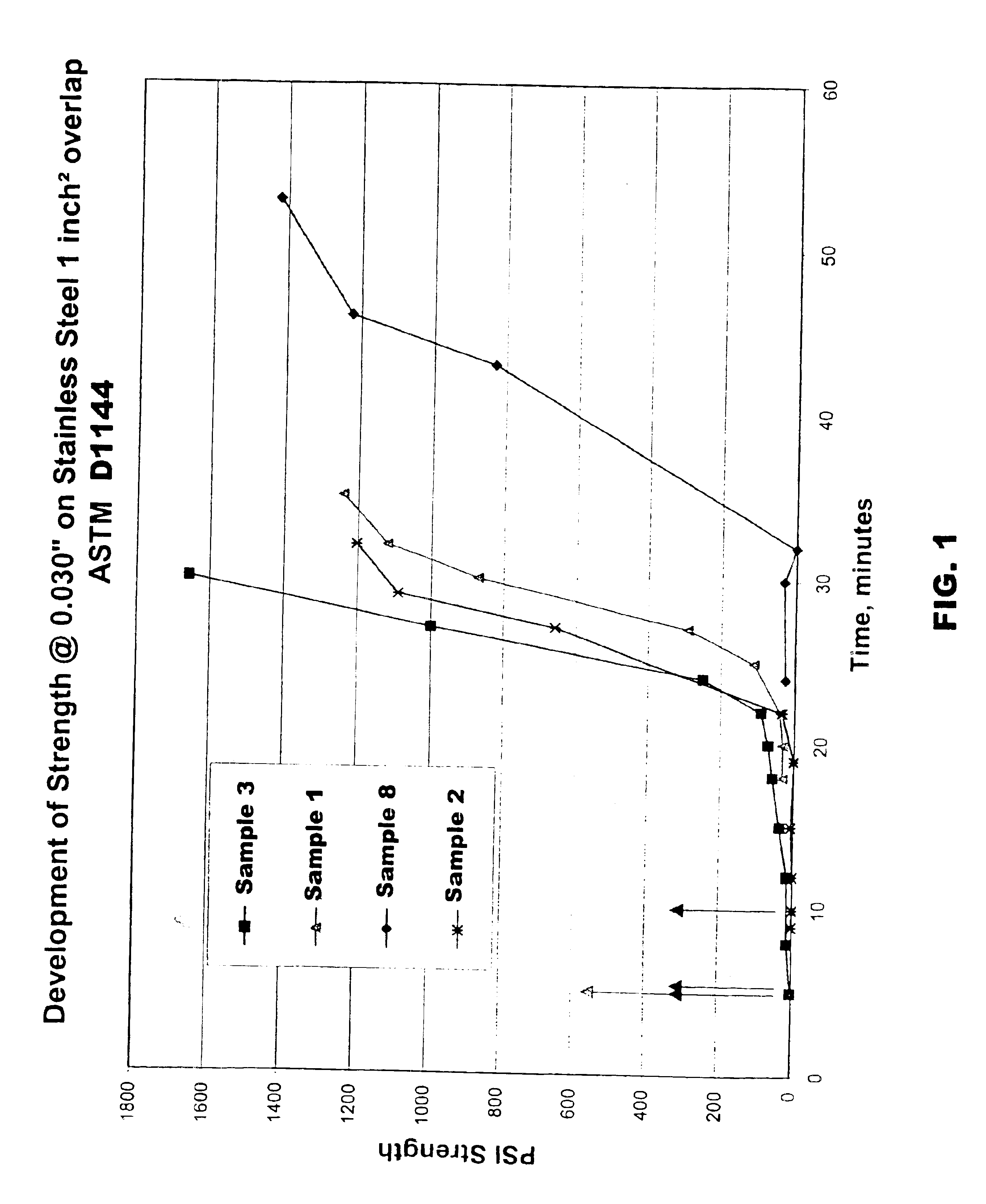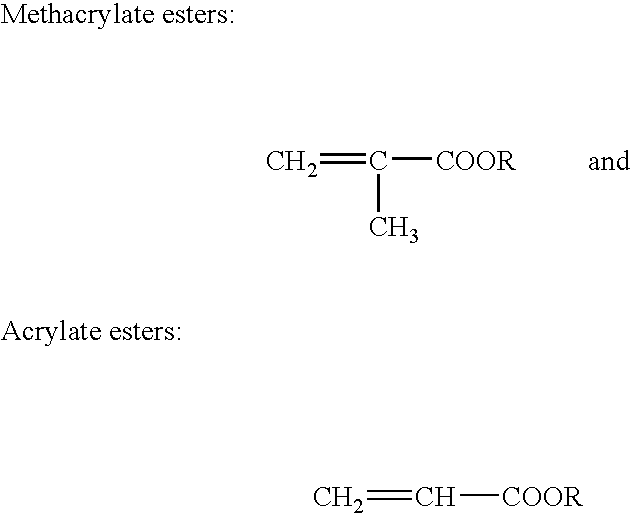Two-part structural adhesive systems and laminates incorporating the same
a structural adhesive and adhesive technology, applied in the field of two-part structural adhesives, can solve the problems of inability to use rivets or other mechanical fasteners, disadvantages of mechanical connectors, appearance, cost or corrosion, etc., and achieve the effects of improving onset of handling strength, superior bond strength and fatigue resistan
- Summary
- Abstract
- Description
- Claims
- Application Information
AI Technical Summary
Benefits of technology
Problems solved by technology
Method used
Image
Examples
##ventive examples 2-8
Inventive Examples 2-8
Inventive adhesives (samples 2-8) were prepared as in Example 1 with decreasing amounts of a group II metal methacrylate salt (zinc dimethacrylate) to a certain the effect of lower concentrations on adhesive properties. The samples were prepared with less than 3 weight percent ex situ zinc dimethacrylate: 2.5; 1; 0.8; and 0 wt. %. The sample were evaluated in the same manner as sample 1. The formulations and test data for samples 2-8 are shown in Table 3.
From Table 3, it is apparent that with decreasing concentrations of zinc dimethacrylate a decrease in fixture time was observed. For example, comparative sample 1 with 3.15 wt. % zinc dimethacrylate exhibted a fixture time of 32 minutes. Sample 2 which contained 2.5 wt. % zinc dimethacrylate exhibited a fixture time of 29 minutes. Sample 3 which contained 1 wt. % zinc dimethacrylate exhibited a fixture time of 24 minutes. Likewise, sample 8 which contained 0.8 wt. % zinc dimethacrylate exhibited a fixture time ...
##ventive examples 9-11
Inventive Examples 9-11
Samples 9-11 were prepared to ascertain the utility of other elastomers in the adhesives of the invention. The adhesives were prepared in the same manner as in the previous examples using a 10:1 volumetric ratio of adhesive to activator. Samples 10 and 11 were prepared with equivalent amounts of commercially available elastomers (Nipol 1472 and Kraton 1116, respectively) dispersed / dissolved in methyl methacrylate. The components and test data are shown in Table 5.
TABLE 5Samples 9-11Tradenames91011MMA8.8499888.849988Carboxylated Chloroprene in MMA (25%)Neoprene AF68.849988Nipol 1472 solution in MMA (25%)Nipol 147260Kraton 1116 solution in MMA (25%)Kraton 1116601,4-NapthoquinoneNQ0.0000120.0000120.0000125% Sodium EDTA solution in 50 / 50EDTA, sodium0.90.90.9water / isopropanolsaltParafin wax, 30% solution in MMABoler Wax 120-3.33.33.3155° F.Melting PointN,N-dimethyl-para-toluidine (DMPT)DMPT0.70.70.7Bis-hydroxyethyl-para-toluidine (HEPT)HEPTBis-hydroxyethyl-meta-tol...
examples 12-13
Samples 12 and 13 were prepared to ascertain the utility of other zinc molybdates dispersions in lieu of Molywhite 101 as used in the previous examples. Samples 12 and 13 were prepared with equivalent amounts of Molywhite 212 and Molywhite 92 as shown in Table 6. As shown in Table 6, both inventive adhesives exhibited fixture times of less than 24 minutes with 20 minutes for sample 12 and 22 minutes for sample 13.
TABLE 6Samples 12-131213MMA15% Chloroprene in MMADupont AD-1070.22 69.961,4-Napthoquinone (NQ, in ppm)0.000012 0.000012 5% Sodium EDTA solution in 50 / 50Aldrich Sodium EDTA0.94 0.94water / isopropanolN,N-dimethyl-para-toluidine (DMPT)First Chemical DMPT0.7 0.7Bis-hydroxyethyl-para-toluidineCognic Emery 5710(HEPT)Bis-hydroxyethyl-meta-toluidineCognis Emery 5714(HEMT)Bis-methacryloxyethyl phosphate (P2M)P2M1.95 1.95Methacrylic Acid (MAA)4.7 4.7Zinc dimethacrylate (Sartomer SR708)Sartomer SR7081 1MBS core-shell (Paraloid BTA-753)Paraloid BTA 75318.5 18.570% Molywhite 212 in...
PUM
| Property | Measurement | Unit |
|---|---|---|
| Tg | aaaaa | aaaaa |
| weight percent | aaaaa | aaaaa |
| wt. % | aaaaa | aaaaa |
Abstract
Description
Claims
Application Information
 Login to View More
Login to View More - R&D
- Intellectual Property
- Life Sciences
- Materials
- Tech Scout
- Unparalleled Data Quality
- Higher Quality Content
- 60% Fewer Hallucinations
Browse by: Latest US Patents, China's latest patents, Technical Efficacy Thesaurus, Application Domain, Technology Topic, Popular Technical Reports.
© 2025 PatSnap. All rights reserved.Legal|Privacy policy|Modern Slavery Act Transparency Statement|Sitemap|About US| Contact US: help@patsnap.com


